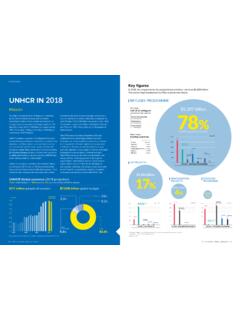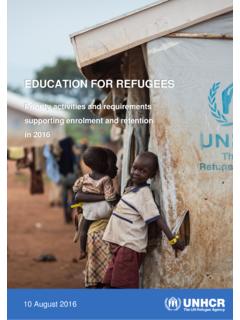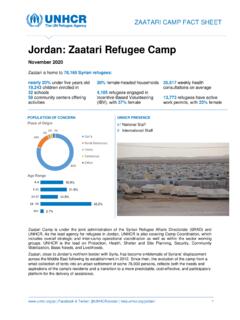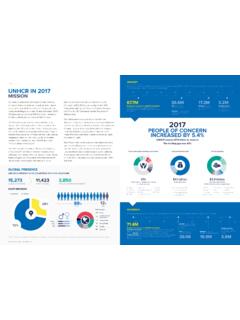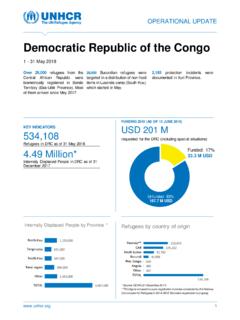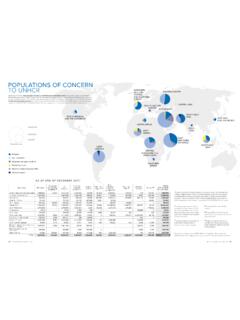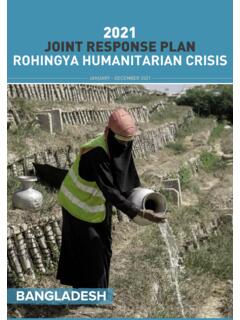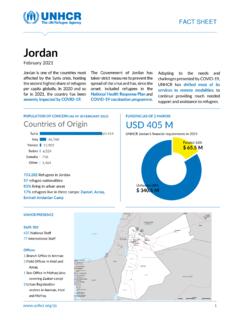Transcription of FACT SHEET Uganda - UNHCR
1 1 org January 2020 Uganda is currently hosting 1,394,678 refugees and continues to receive simultaneous arrivals from the Democratic Republic of Congo (DRC), South Sudan and Burundi. The number of South Sudanese refugees in Uganda is over eight hundred thousand, and arrivals from the DRC have been on the rise since the beginning of 2020. Chronic underfunding of the refugee response threatens the ability of humanitarian organisations to continue delivering lifesaving and critical assistance. A creatively constructed house by a refugee in Rwamanja refugee settlement, Kamwenge district. Photo UNHCR /Duniya Aslam Khan POPULATION OF CONCERN: 1,394,678 UNHCR s Financial Requirements 2020: USD Countries of Origin* UNHCR Funding (as of 31 January 2020) South Sudan 867,453 DR Congo 402,521 Burundi 46,707 Others 77,997 TOTAL 1,394,678 Total refugees and asylum-seekers in Uganda as of 31 January 2020 *These include refugees from Somalia, Rwanda, Eritrea, Ethiopia, Sudan and other countries of origin.
2 Unfunded 91% - 302M Funded 9% - 29M FACT SHEET Uganda UNHCR PRESENCE Staff: 462 National Staff 116 International Staff 08 IUNV 02 NUNV 38 National UNOPS 05 International UNOPS Offices: One Representation Office in Kampala Five Sub Offices in Arua, Mbarara, Moyo, Pakelle and Yumbe Six Field Units in Kiryandongo, Kyaka II, Kyangwali, Lamwo, Nakivale, and Rwamwanja. FACT SHEET > Uganda / JANUARY 2020 2 org Uganda has 13 refugees hosting districts (Adjumani, Arua, Isingiro, Kampala, Kamwenge, Kikuube, Kiryandongo, Kyegegwa, Koboko, Lamwo, Madi-Okollo, Obongi and Yumbe). The refugees are hosted in 13 settlements (Adjumani1, Bidibidi, Imvepi, Kiryandongo, Kyaka II, Kyangwali, Lobule, Nakivale, Oruchinga, Palabek, Parlorinya, Rhino Camp, Rwamanja) plus the urban refugees in Kampala. 1 Adjumani is made up of 18 settlements FACT SHEET > Uganda / JANUARY 2020 3 org Main Activities Implementation of the Global Compact on Refugees and its Comprehensive Refugee Response Framework (CRRF) The Comprehensive Refugee Response Framework (CRRF) is in its fourth year of implementation in Uganda .
3 This builds on considerable progress made since 2017, when the Government of Uganda launched this multi-stakeholder and partnership approach to the refugee response. The Ugandan approach promotes self - reliance for refugees and measures to ease the pressure on refugee-hosting districts. The National Plan of Action to implement the Global Compact on Refugees and its CRRF, define the milestones to be reached until the end of 2020. An important element of the CRRF in Uganda is inclusion of refugees in national planning and local development. In order to ease pressure on refugee-hosting districts and to enhance service delivery for both refugees and host communities, comprehensive sectoral plans have been formulated which link the refugee response to government sector plans. The plans also enable Uganda to clearly highlight where the international community may usefully channel support for a comprehensive and people-centred response in its refugee hosting districts.
4 UNHCR has aligned its strategies with these comprehensive plans and supports the coordination structures for CRRF implementations, such as the Secretariat for the Education Response Plan for (ERP) and the CRRF Secretariat in OPM which provides services for the CRRF Steering Group. Whereas refugees had already been included in the National Development Plan II (2016 2020) through the Settlement Transformative Agenda (STA), they are mainstreamed across sectors in planning and statistical products within NDP III, which will enter into effect on 01 July 2020. Refugee-hosting districts will now include refugees in their planning for the next five years. UNHCR is working closely with the refugee-hosting districts to provide analysis on refugees in the settlements and support the planning processes for these District Development Plans (DDPs). UNHCRs continues to foster a multi-stakeholder and partnership approach and to strengthen its convening role aimed at mobilizing and coordinating support, particularly regarding economic and social inclusion.
5 Close collaboration with development partners has allowed for the handover of activities, which were previously funded by UNHCR , such as Refugee and Host Population Empowerment (ReHope) projects and livelihoods . Development partners have also extended services for water and environment, allowing UNHCR to play a more catalytic and coordination role. Protection UNHCR works with the Government of Uganda to provide effective protection for refugees and asylum-seekers in Uganda . Uganda s vision, as articulated in the 2016-2020 Multiyear Multi Partner Protection and Solutions Strategy (MYMPSS), is to ensure that, through Uganda s CRRF, refugees are protected by the Government, live in safety and dignity with host communities, and progressively attain lasting solutions. The aim is to transition emergency response into sustainable solutions and government-led actions in refugee-hosting districts.
6 The strategic objectives under the MYMPSS are as follows: 1. Uganda s asylum space is maintained, unhindered access to territory is preserved and government s emergency preparedness and response capacity is progressively strengthened. FACT SHEET > Uganda / JANUARY 2020 4 org 2. Promoting the full enjoyment of rights and international protection standards throughout the displacement cycle. 3. Progressively attain inclusion and self - reliance of refugees and host communities through development of individual capacities and the promotion of a conducive environment for livelihoods opportunities. 4. Provision of integrated basic social services, including health, education, child protection and WASH, provided by national authorities in refugee hosting districts. 5. Improved opportunities for durable solutions, either for refugees to return voluntarily to their countries of origin; have found 3rd Country Solutions or have attained enough socio- economic empowerment, including ability to exercise their full range of rights to integrate locally in Uganda .
7 Durable Solutions UNHCR facilitates voluntary repatriation when conditions in the country of origin have improved. On a limited basis, it also facilitates resettlement whereby a refugee or a refugee family leaves the country of asylum and legally settles in third country. UNHCR is currently working together with the Government of Uganda on creative legal solutions for long-staying refugees that are unwilling or unable to return home. In the current circumstance, UNHCR is not promoting voluntary repatriation to any of the countries of origin. Resettlement and third country admissions are part of solutions for refugees and plays an integral role in the Ugandan national plan of action on the implementation the Global Compact on Refugees (GCR) and its Comprehensive Refugee Response Framework (CRRF) in Uganda . Resettlement from Uganda is a tangible demonstration of solidarity to a host country, which has maintained its generous asylum policy, while responding to multiple emergencies.
8 UNHCR supports third country admissions such as private sponsorship, student visas, and family reunifications schemes. Canada, Ireland and United States of America (USA), have offered complementary pathways for refugees in Uganda . UNHCR continues to advocate for an increase in the number of refugees who will benefit from these admissions. Education UNHCR provides service delivery to refugees and supports strengthening of Government systems. Together with NGO partners, UNHCR provides education services in over 250 settlement schools at primary and secondary level, supporting 274,755 children to access education. UNCHR and UNICEF lead in the area of system strengthening , together with the Ministry of Education and Sports (MoES). In addition to setting up of a Kampala office, UNHCR procured items such as motorbikes, office furniture and ICT equipment to support the work of MoES at district level.
9 This donation will help government education personnel collect data and inspect schools in all refugee-hosting districts. UNHCR also continues to support district level engagement for the development of district costing models and prioritisation of needs and activities. District level plans will ensure greater ownership and engagement of the Education Response Plan and a more targeted approach to needs and gaps. Education remains a key priority for UNHCR in Uganda given that, 51percent of the refugee population is school-age children (aged 3-17),. Education also key as a protection and solutions tool. At the end of the 2019 academic year (December 2019), 76 percent (254,442) of refugee children were enrolled in UNHCR supported primary schools and 11 percent (20,313) were enrolled in secondary schools within the settlements. Compared to 2018, this is an increase of 10,258 pupils and 2,775 students in primary and secondary schools respectively FACT SHEET > Uganda / JANUARY 2020 5 org Health The Uganda refugee operation has a total of 2,221 health workers across all settlements of which, 41 are medical doctors.
10 Consultation per clinicians per day is at 58 against the standard of 50. Refugees access health services from 100 health facilities in the settlements, with district hospitals, regional referral hospitals and Mulago National Referral Hospital, acting as referral points for the secondary and tertiary health care. Disease prevention activities are continuously carried out to minimize the number of outbreaks such as measles, watery diarrhea and cholera in the operation. A total of 17,996 patients are currently receiving HIV care and treatment in the facilities within the settlements, of which 38 percent (6,857) are refugees. Prevention of Mother-to-Child Transmission (PMTCT) services are provided to the refugees and host population, as a measure of preventing the spread of HIV to from positive mothers to the babies. Under maternal and child health care, maternal mortality rate is at 172 deaths per 100,000 live births.
